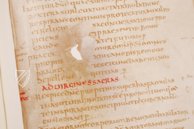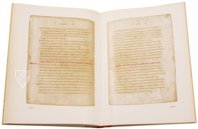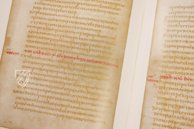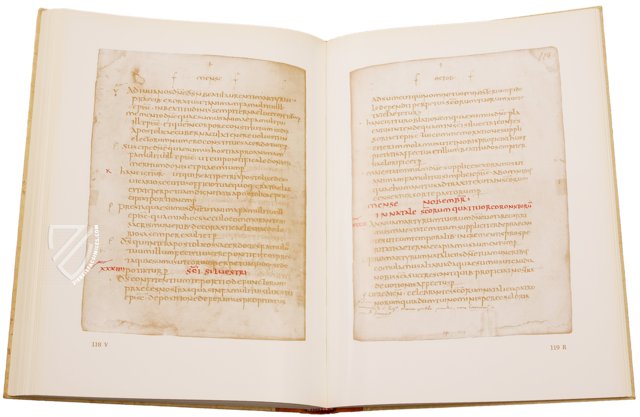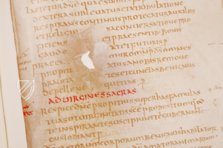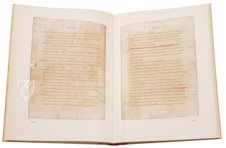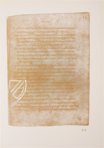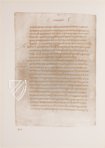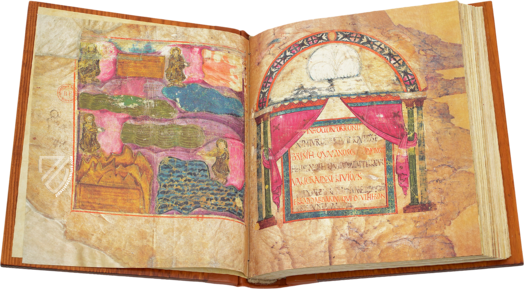Sacramentarium Leonianum
(under 1,000€)
The Sacramentarium Leonianum is a 6th century document of tremendous importance because it is the oldest surviving liturgical book containing the Roman rite and some of the oldest prayers in the Catholic Church. Its name derives from its connection to Pope Leo I, who supposedly authored some of the texts during the 5th century, and is also called the “Verona Sacramentary” after its repository in the Chapter Library of Verona Cathedral, where it was discovered in 1713. However, it is not a sacramentary in the strict sense of the word and contains prayers as they would be performed as part of the stationary Mass by the Pontiff in various churches and basilicas in and around Rome. It also includes texts for the dedication of churches, consecration of bishops, ordination of deacons, and other rituals. Still regarded as an authoritative liturgical text, the incredible manuscript is a document of tremendous historical and theological value.
Sacramentarium Leonianum
Most students of early church history are unaware of how much they owe to the discovery of a manuscript in 1713 by Francesco Scipione, Marchese di Maffei (1675–1755). Containing texts from the 5th and 6th centuries, it is counted among the oldest surviving liturgical books in the Latin West and is a precious resource for theologians, paleographers, and historians alike. It is known alternately as the Sacramentarium Leonianum because some of the texts are historically attributed to Pope Leo I (ca. 400–461) albeit without proof, or the Sacramentarium Veronense after the city of Verona where it was rediscovered and still resides today. Whatever you call it, the collection of religious texts, although not a sacramentary in the strict sense of the word, offers a rare and precious view into Late Antiquity and the liturgical foundations of the Catholic Church.
Tumulutuous Origins
Although it was originally thought that the manuscript dated from the 5th century reign of Leo the Great, later generations of researchers discovered an allusion in the manuscript to the unsuccessful attempt to besiege Rome by the Ostrogoths in 537–538, The manuscript thus likely originated in Rome during the mid-6th century and possibly as late as the early 7th century. This was a terrible time in the history of Italy, which was devasted and depopulated in the course of the 19-year-long Gothic War of 535–554 and the concurrent Plague of Justinian. Rome itself changed hands between the Goths and Byzantines numerous times and the great Italian cities shrank dramatically.
Lombards soon came to occupy most of the interior lands while many coastal cities and parts of the south remained in the Byzantine sphere of influence until the late-11th century and the Italian Peninsula would stay politically divided until the 19th century. Nevertheless, classical culture continued to thrive within the cloistered life of the clergy and in the Byzantine cities. This was also the period of the Byzantine Papacy, when popes were appointed by or required the approval of the emperor in Constantinople. The art and liturgy produced under various popes of Greek, Sicilian, and Syrian origins exhibit a true blending of Eastern and Western Christian traditions.
Contents of the “Sacramentary”
This is not considered to be a sacramentary because it does not include either the Canon or Ordinary of the Mass, only the Proper consisting of Collections, Secrets, Prefaces, Post-communions, and Orationes Super Populum. The fact that the manuscript contains the pure and unadulterated Roman rite without Gallican additions indicates that it originated at the beginning of the Byzantine Papacy, and it has been theorized that the text may have been originally intended for the use of a missionary in Gaul. It also contains many references to local Roman festivals, especially those dedicated to Peter and Paul, the Patron Saints of Rome, which number no less than twenty-eight. There are also twenty-three masses for celebrating the consecration of a bishop and many more for similar occasions.
The form of the manuscript does not lend itself for liturgical use and thus most have been designed for private use as a referential text almost as though it were a liturgical encyclopedia. Furthermore, the text is not arranged according to the liturgical calendar but to the Romans’ civil calendar. Unfortunately, the pages concerning the first four months of the year are lost and as such, there is no information concerning the Easter Vigil, the highpoint of the liturgical year. Mistakes made in the manuscript appear to be from the scribes being rushed in its creation. Nonetheless, this is a precious and authoritative artifact of ancient liturgy.
Fortuitous Rediscovery
Francesco Scipione Maffei was a Venetian bibliophile, antiquarian, author, and art critic who had an exciting youth including serving as an officer in the Bavarian Army during the War of Spanish Succession (1701–14) before he returned to Italy in 1705. After beginning a successful career as an author on Roman history and expert on Etruscan antiquities in Padua, he came to Verona where he contributed to the discovery of numerous important manuscripts in the cathedral’s library, the crown jewel of which was the Sacramentarium Leonianum in 1713. It was first published by the Verona-born liturgical scholar Giuseppe Bianchini (1704–64) as part of his four-volume Anastasii bibliothecarii vitae Romanorum Pontificum in 1735 and has been intensely studied ever since. The manuscript remains the highlight of the prestigious collections of the Chapter Library of Verona Cathedral where it is stored under the shelf mark Codex Veronensis LXXXV (80).
Codicology
- Alternative Titles
- Sacramentarium Veronense
Verona Sacramentary
Leonine Sacramentary - Date
- Mid 6th century
- Epochs
- Style
- Genre
- Language
- Illustrations
- Headings and annotations in bold red script
- Artist / School
- Pope Leo I (ca. 400–461) (author)
Sacramentarium Leonianum
Readings for October
The contents of the manuscript are arranged according to the months of the Roman civil calendar rather than the liturgical year. It was not designed to be used in the performance of Mass or any other rituals but served as more of a reference work for the clergy, which is further indicated by the marginal notations made in a second hand from the original scribe.
The text is clearly the product of a skilled scribe working in a monastic scriptorium. Most of the text, which is written in a majuscule script without spacing in order fit as many words on the page as possible, is written using brown ink with the heading of the next section written in more expensive red ink. Aside from some water damage along the edges, this 1,500-year-old page has survived in remarkably good conditions.

#1 Das Sacramentarium Leonianum
Language: German
(under 1,000€)
- Treatises / Secular Books
- Apocalypses / Beatus
- Astronomy / Astrology
- Bestiaries
- Bibles / Gospels
- Chronicles / History / Law
- Geography / Maps
- Saints' Lives
- Islam / Oriental
- Judaism / Hebrew
- Single Leaf Collections
- Leonardo da Vinci
- Literature / Poetry
- Liturgical Manuscripts
- Medicine / Botany / Alchemy
- Music
- Mythology / Prophecies
- Psalters
- Other Religious Books
- Games / Hunting
- Private Devotion Books
- Other Genres
- Afghanistan
- Armenia
- Austria
- Belgium
- Belize
- Bosnia and Herzegovina
- China
- Colombia
- Costa Rica
- Croatia
- Cyprus
- Czech Republic
- Denmark
- Egypt
- El Salvador
- Ethiopia
- France
- Germany
- Greece
- Guatemala
- Honduras
- Hungary
- India
- Iran
- Iraq
- Israel
- Italy
- Japan
- Jordan
- Kazakhstan
- Kyrgyzstan
- Lebanon
- Liechtenstein
- Luxembourg
- Mexico
- Morocco
- Netherlands
- Palestine
- Panama
- Peru
- Poland
- Portugal
- Romania
- Russia
- Serbia
- Spain
- Sri Lanka
- Sweden
- Switzerland
- Syria
- Tajikistan
- Turkey
- Turkmenistan
- Ukraine
- United Kingdom
- United States
- Uzbekistan
- Vatican City
- A. Oosthoek, van Holkema & Warendorf
- Aboca Museum
- Ajuntament de Valencia
- Akademie Verlag
- Akademische Druck- u. Verlagsanstalt (ADEVA)
- Aldo Ausilio Editore - Bottega d’Erasmo
- Alecto Historical Editions
- Alkuin Verlag
- Almqvist & Wiksell
- Amilcare Pizzi
- Andreas & Andreas Verlagsbuchhandlung
- Archa 90
- Archiv Verlag
- Archivi Edizioni
- Arnold Verlag
- ARS
- Ars Magna
- ArtCodex
- AyN Ediciones
- Azimuth Editions
- Badenia Verlag
- Bärenreiter-Verlag
- Belser Verlag
- Belser Verlag / WK Wertkontor
- Benziger Verlag
- Bernardinum Wydawnictwo
- BiblioGemma
- Biblioteca Apostolica Vaticana (Vaticanstadt, Vaticanstadt)
- Bibliotheca Palatina Faksimile Verlag
- Bibliotheca Rara
- Boydell & Brewer
- Bramante Edizioni
- Bredius Genootschap
- Brepols Publishers
- British Library
- C. Weckesser
- Caixa Catalunya
- Canesi
- CAPSA, Ars Scriptoria
- Caratzas Brothers, Publishers
- Carus Verlag
- Casamassima Libri
- Centrum Cartographie Verlag GmbH
- Chavane Verlag
- Christian Brandstätter Verlag
- Circulo Cientifico
- Club Bibliófilo Versol
- Club du Livre
- CM Editores
- Collegium Graphicum
- Collezione Apocrifa Da Vinci
- Comissão Nacional para as Comemorações dos Descobrimentos Portugueses
- Coron Verlag
- Corvina
- CTHS
- D. S. Brewer
- Damon
- De Agostini/UTET
- De Nederlandsche Boekhandel
- De Schutter
- Deuschle & Stemmle
- Deutscher Verlag für Kunstwissenschaft
- DIAMM
- Droz
- E. Schreiber Graphische Kunstanstalten
- Ediciones Boreal
- Ediciones Grial
- Ediclube
- Edições Inapa
- Edilan
- Editalia
- Edition Deuschle
- Edition Georg Popp
- Edition Leipzig
- Edition Libri Illustri
- Editiones Reales Sitios S. L.
- Éditions de l'Oiseau Lyre
- Editions Medicina Rara
- Editorial Casariego
- Editorial Mintzoa
- Editrice Antenore
- Editrice Velar
- Edizioni Edison
- Egeria, S.L.
- Eikon Editores
- Electa
- Emery Walker Limited
- Enciclopèdia Catalana
- Eos-Verlag
- Ephesus Publishing
- Ernst Battenberg
- Eugrammia Press
- Extraordinary Editions
- Fackelverlag
- Facsimila Art & Edition
- Facsimile Editions Ltd.
- Facsimilia Art & Edition Ebert KG
- Faksimile Verlag
- Feuermann Verlag
- Folger Shakespeare Library
- Franco Cosimo Panini Editore
- Friedrich Wittig Verlag
- Fundación Hullera Vasco-Leonesa
- G. Braziller
- Gabriele Mazzotta Editore
- Gebr. Mann Verlag
- Gesellschaft für graphische Industrie
- Getty Research Institute
- Giovanni Domenico de Rossi
- Giunti Editore
- Graffiti
- Grafica European Center of Fine Arts
- Guido Pressler
- Guillermo Blazquez
- Gustav Kiepenheuer
- H. N. Abrams
- Harrassowitz
- Harvard University Press
- Helikon
- Hendrickson Publishers
- Henning Oppermann
- Herder Verlag
- Hes & De Graaf Publishers
- Hoepli
- Holbein-Verlag
- Houghton Library
- Hugo Schmidt Verlag
- Idion Verlag
- Il Bulino, edizioni d'arte
- ILte
- Imago
- Insel Verlag
- Insel-Verlag Anton Kippenberger
- Instituto de Estudios Altoaragoneses
- Instituto Nacional de Antropología e Historia
- Introligatornia Budnik Jerzy
- Istituto dell'Enciclopedia Italiana - Treccani
- Istituto Ellenico di Studi Bizantini e Postbizantini
- Istituto Geografico De Agostini
- Istituto Poligrafico e Zecca dello Stato
- Italarte Art Establishments
- Jan Thorbecke Verlag
- Johnson Reprint Corporation
- Josef Stocker
- Josef Stocker-Schmid
- Jugoslavija
- Karl W. Hiersemann
- Kasper Straube
- Kaydeda Ediciones
- Kindler Verlag / Coron Verlag
- Kodansha International Ltd.
- Konrad Kölbl Verlag
- Kurt Wolff Verlag
- La Liberia dello Stato
- La Linea Editrice
- La Meta Editore
- Lambert Schneider
- Landeskreditbank Baden-Württemberg
- Leo S. Olschki
- Les Incunables
- Liber Artis
- Library of Congress
- Libreria Musicale Italiana
- Lichtdruck
- Lito Immagine Editore
- Lumen Artis
- Lund Humphries
- M. Moleiro Editor
- Maison des Sciences de l'homme et de la société de Poitiers
- Manuscriptum
- Martinus Nijhoff
- Maruzen-Yushodo Co. Ltd.
- MASA
- Massada Publishers
- McGraw-Hill
- Metropolitan Museum of Art
- Militos
- Millennium Liber
- Müller & Schindler
- Nahar - Stavit
- Nahar and Steimatzky
- National Library of Wales
- Neri Pozza
- Nova Charta
- Oceanum Verlag
- Odeon
- Orbis Mediaevalis
- Orbis Pictus
- Österreichische Staatsdruckerei
- Oxford University Press
- Pageant Books
- Parzellers Buchverlag
- Patrimonio Ediciones
- Pattloch Verlag
- PIAF
- Pieper Verlag
- Plon-Nourrit et cie
- Poligrafiche Bolis
- Presses Universitaires de Strasbourg
- Prestel Verlag
- Princeton University Press
- Prisma Verlag
- Priuli & Verlucca, editori
- Pro Sport Verlag
- Propyläen Verlag
- Pytheas Books
- Quaternio Verlag Luzern
- Reales Sitios
- Recht-Verlag
- Reichert Verlag
- Reichsdruckerei
- Reprint Verlag
- Riehn & Reusch
- Roberto Vattori Editore
- Rosenkilde and Bagger
- Roxburghe Club
- Salerno Editrice
- Saltellus Press
- Sandoz
- Sarajevo Svjetlost
- Schöck ArtPrint Kft.
- Schulsinger Brothers
- Scolar Press
- Scrinium
- Scripta Maneant
- Scriptorium
- Shazar
- Siloé, arte y bibliofilia
- SISMEL - Edizioni del Galluzzo
- Sociedad Mexicana de Antropología
- Société des Bibliophiles & Iconophiles de Belgique
- Soncin Publishing
- Sorli Ediciones
- Stainer and Bell
- Studer
- Styria Verlag
- Sumptibus Pragopress
- Szegedi Tudomànyegyetem
- Taberna Libraria
- Tarshish Books
- Taschen
- Tempus Libri
- Testimonio Compañía Editorial
- Thames and Hudson
- The Clear Vue Publishing Partnership Limited
- The Facsimile Codex
- The Folio Society
- The Marquess of Normanby
- The Richard III and Yorkist History Trust
- Tip.Le.Co
- TouchArt
- TREC Publishing House
- TRI Publishing Co.
- Trident Editore
- Tuliba Collection
- Typis Regiae Officinae Polygraphicae
- Union Verlag Berlin
- Universidad de Granada
- University of California Press
- University of Chicago Press
- Urs Graf
- Vallecchi
- Van Wijnen
- VCH, Acta Humaniora
- VDI Verlag
- VEB Deutscher Verlag für Musik
- Verlag Anton Pustet / Andreas Verlag
- Verlag Bibliophile Drucke Josef Stocker
- Verlag der Münchner Drucke
- Verlag für Regionalgeschichte
- Verlag Styria
- Vicent Garcia Editores
- W. Turnowski Ltd.
- W. Turnowsky
- Waanders Printers
- Wiener Mechitharisten-Congregation (Wien, Österreich)
- Wissenschaftliche Buchgesellschaft
- Wissenschaftliche Verlagsgesellschaft
- Wydawnictwo Dolnoslaskie
- Xuntanza Editorial
- Zakład Narodowy
- Zollikofer AG






